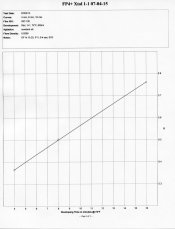swmcl
Member
OK.
So. As we lower our concentration of developer chemicals we'll get more and more unreliable results. I'm sort of taking that as a given. Some of you may qualify this a little for me and tell me it is not so true for certain mixes and that some are better at being reliable and predictable at high dilutions.
I'm struggling here with my testing.
As I go to higher dilutions I'm trying to get a reliable low contrast negative. What I'm getting is a wobbly curve and the curve are not separating from one another as I would wish (the 5min and 6 min curves are too close to each other).
I'm also aware of the 'induction time' and that this will be affected by dilution also.
What is your experience ? Is a reliable low contrast negative possible ? (lets say lower than 0.5 or 0.48) Assuming a single process - not some split development or some such. Assuming the use of a Jobo tank in a rotary fashion.
It seems to me that FP4 in this case seems to not like really low gradients. I'm using Pyrocat HD at 4:4:300 in this set of results at 20 C and 6rpm in a Jobo 3006.
The results show nothing happening and them BAM! it takes off at a crazy rate of knots (for the dilution).
I should mention that I have some really nice predictable results at 5:5:300 and 6:6:300. 5mins at 5:5:300 is giving me 0.48 but it is too short to be reliable so I'm chasing low gradients and want the developing time to be lowish. I'm also wanting the strength of the developer to be strong enough to develop a really long SBR. I am cautious about a weak solution ever being able to develop stronger highlights. I'd rather have a stronger solution for a shorter time.
I'd be happy knowing I could have a straight line and reliable development of say 0.43 for say 7min.
I'll try to attach a simple pdf. The graph is on the second page.
Cheers,
Steve
So. As we lower our concentration of developer chemicals we'll get more and more unreliable results. I'm sort of taking that as a given. Some of you may qualify this a little for me and tell me it is not so true for certain mixes and that some are better at being reliable and predictable at high dilutions.
I'm struggling here with my testing.
As I go to higher dilutions I'm trying to get a reliable low contrast negative. What I'm getting is a wobbly curve and the curve are not separating from one another as I would wish (the 5min and 6 min curves are too close to each other).
I'm also aware of the 'induction time' and that this will be affected by dilution also.
What is your experience ? Is a reliable low contrast negative possible ? (lets say lower than 0.5 or 0.48) Assuming a single process - not some split development or some such. Assuming the use of a Jobo tank in a rotary fashion.
It seems to me that FP4 in this case seems to not like really low gradients. I'm using Pyrocat HD at 4:4:300 in this set of results at 20 C and 6rpm in a Jobo 3006.
The results show nothing happening and them BAM! it takes off at a crazy rate of knots (for the dilution).
I should mention that I have some really nice predictable results at 5:5:300 and 6:6:300. 5mins at 5:5:300 is giving me 0.48 but it is too short to be reliable so I'm chasing low gradients and want the developing time to be lowish. I'm also wanting the strength of the developer to be strong enough to develop a really long SBR. I am cautious about a weak solution ever being able to develop stronger highlights. I'd rather have a stronger solution for a shorter time.
I'd be happy knowing I could have a straight line and reliable development of say 0.43 for say 7min.
I'll try to attach a simple pdf. The graph is on the second page.
Cheers,
Steve




